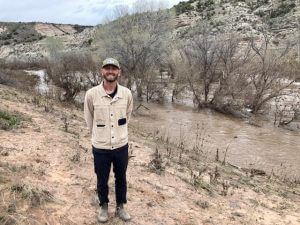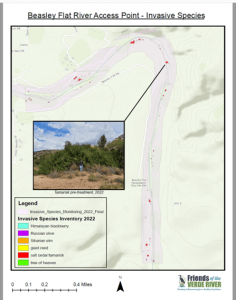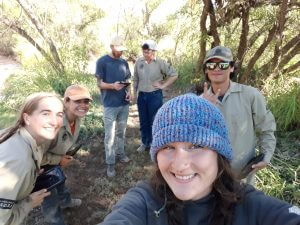Community Stewardship of Wild and Scenic Rivers
Watching the Verde’s muddy-colored water soar downstream following several days of rain was an impressive reminder of how dynamic our rivers are as well as the flooding you can encounter

Hudson Keiffer, Friends of the Verde River
even in places we think of as arid or dry. Despite the rain, we were on a tour with Friends of the Verde River’s Restoration Technician, Hudson Keiffer, who was showing us their work to remove invasive species directly above the portion of the Verde that is designated as a Wild and Scenic River. Friends of the Verde River is a local watershed organization in northern Arizona working collaboratively for a healthy Verde River, and their goal with this project was to engage young adults and volunteers in the restoration of riverside habitat near a much-used picnic area and river access point that swells with people enjoying the river for much of the year (watch Friend’s Executive Director Nancy Steele discuss building collaboratives to leverage federal funding here).
This project was one of the seven Wild and Scenic River Stewardship Partners projects that River Network funded in 2022 with support from the U.S. Forest Service (USFS) as part of our efforts to expand resources for our network to achieve Healthy and Resilient Rivers. The National Wild & Scenic River System covers over 13,400 river miles from coast to coast in 41 states and Puerto Rico. Wild and Scenic Rivers (WSR) are free-flowing rivers and help preserve unique values including recreation, fish and wildlife habitat, water quality, and cultural heritage. USFS manages over 5,000 of these WSR miles and, recognizing the efforts of local organizations and communities to protect these rivers, began funding the WSR Stewardship Partners program five years ago to further support these shared stewardship approaches.
 At the Verde, Hudson showed us where Friends of the Verde River, working with Arizona Conservation Corps and Verde Earth Technologies, identified, mapped and removed invasive species including tamarisk and tree of heaven, which threaten the health of the Verde. The Verde WSR is recognized for its scenery and wildlife supported by its lush riverside (or riparian) habitat, that supports a diversity of birds and wildlife. Tamarisk, especially when it becomes dense, can use more water than native species, leading to river and groundwater depletion.Friends of the Verde River first mapped the river section to identify stands of invasive species and then trained 12 Arizona Conservation Corps members to remove these plants using targeted pesticides and physical removal, ultimately treating 44 acres. The group also worked with Prescott National Forest staff to collect and store native willow poles for future restoration planting at the site. This project reflects the time-consuming and challenging nature of stewardship work that requires both commitment and collaboration to protect and restore native habitat around our Wild and Scenic Rivers.
At the Verde, Hudson showed us where Friends of the Verde River, working with Arizona Conservation Corps and Verde Earth Technologies, identified, mapped and removed invasive species including tamarisk and tree of heaven, which threaten the health of the Verde. The Verde WSR is recognized for its scenery and wildlife supported by its lush riverside (or riparian) habitat, that supports a diversity of birds and wildlife. Tamarisk, especially when it becomes dense, can use more water than native species, leading to river and groundwater depletion.Friends of the Verde River first mapped the river section to identify stands of invasive species and then trained 12 Arizona Conservation Corps members to remove these plants using targeted pesticides and physical removal, ultimately treating 44 acres. The group also worked with Prescott National Forest staff to collect and store native willow poles for future restoration planting at the site. This project reflects the time-consuming and challenging nature of stewardship work that requires both commitment and collaboration to protect and restore native habitat around our Wild and Scenic Rivers.
Given the success of this and other projects, we’re excited to announce the availability of Wild and Scenic River Stewardship Partners funding for 2023, with awards for stewardship projects and planning and a new set of awards for planning and relationship building. Applications are due May 19th – learn more here.

Arizona Conservation Corps team – Friends of the Verde River






